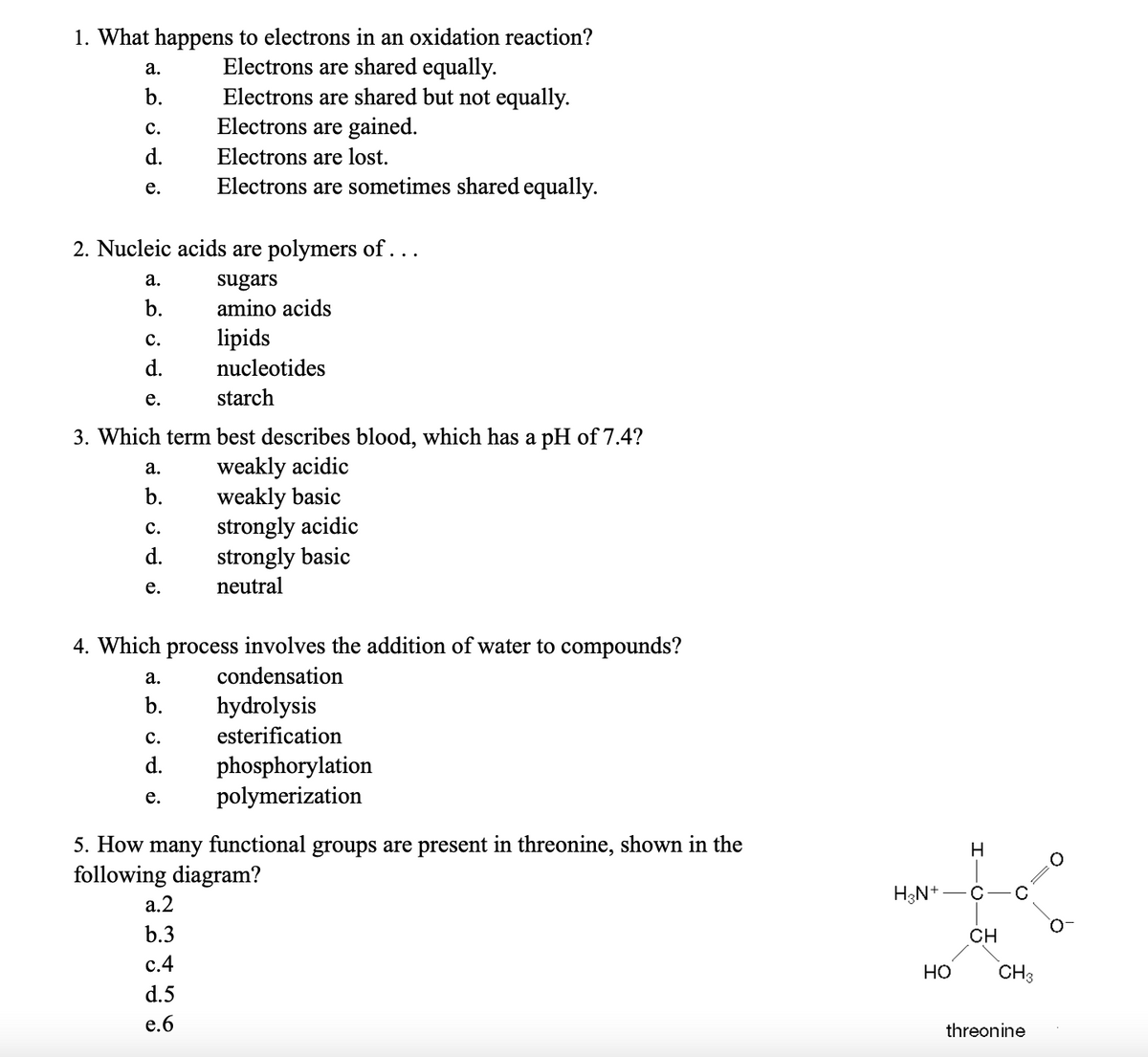1. What happens to electrons in an oxidation reaction? Electrons are shared equally. Electrons are shared but not equally. Electrons are gained. Electrons are lost. Electrons are sometimes shared equally. a. b. C. d. e. 2. Nucleic acids are polymers of ... sugars amino acids lipids nucleotides starch 3. Which term best describes blood, which has a pH of 7.4? weakly acidic weakly basic strongly acidic strongly basic neutral a. b. C. d. e. a. b. C. d. e. 4. Which process involves the addition of water to compounds?
1. What happens to electrons in an oxidation reaction? Electrons are shared equally. Electrons are shared but not equally. Electrons are gained. Electrons are lost. Electrons are sometimes shared equally. a. b. C. d. e. 2. Nucleic acids are polymers of ... sugars amino acids lipids nucleotides starch 3. Which term best describes blood, which has a pH of 7.4? weakly acidic weakly basic strongly acidic strongly basic neutral a. b. C. d. e. a. b. C. d. e. 4. Which process involves the addition of water to compounds?
Biology: The Dynamic Science (MindTap Course List)
4th Edition
ISBN:9781305389892
Author:Peter J. Russell, Paul E. Hertz, Beverly McMillan
Publisher:Peter J. Russell, Paul E. Hertz, Beverly McMillan
Chapter2: Life, Chemistry, And Water
Section: Chapter Questions
Problem 3TYK: The chemical activity of an atom: a. depends on the electrons in the outermost energy level. b. is...
Related questions
Question

Transcribed Image Text:1. What happens to electrons in an oxidation reaction?
Electrons are shared equally.
Electrons are shared but not equally.
Electrons are gained.
Electrons are lost.
Electrons are sometimes shared equally.
a.
b.
C.
d.
e.
2. Nucleic acids are polymers of...
sugars
amino acids
lipids
nucleotides
starch
3. Which term best describes blood, which has a pH of 7.4?
weakly acidic
weakly basic
strongly acidic
strongly basic
neutral
a.
b.
C.
d.
e.
a.
b.
C.
d.
e.
4. Which process involves the addition of water to compounds?
condensation
a.
ن ف نے
b.
C.
d.
e.
hydrolysis
esterification
a.2
b.3
c.4
d.5
e.6
phosphorylation
polymerization
5. How many functional groups are present in threonine, shown in the
following diagram?
H₂N+
HO
H
с
CH
CH3
threonine
Expert Solution
This question has been solved!
Explore an expertly crafted, step-by-step solution for a thorough understanding of key concepts.
Step by step
Solved in 3 steps

Recommended textbooks for you

Biology: The Dynamic Science (MindTap Course List)
Biology
ISBN:
9781305389892
Author:
Peter J. Russell, Paul E. Hertz, Beverly McMillan
Publisher:
Cengage Learning

Biology (MindTap Course List)
Biology
ISBN:
9781337392938
Author:
Eldra Solomon, Charles Martin, Diana W. Martin, Linda R. Berg
Publisher:
Cengage Learning


Biology: The Dynamic Science (MindTap Course List)
Biology
ISBN:
9781305389892
Author:
Peter J. Russell, Paul E. Hertz, Beverly McMillan
Publisher:
Cengage Learning

Biology (MindTap Course List)
Biology
ISBN:
9781337392938
Author:
Eldra Solomon, Charles Martin, Diana W. Martin, Linda R. Berg
Publisher:
Cengage Learning


Concepts of Biology
Biology
ISBN:
9781938168116
Author:
Samantha Fowler, Rebecca Roush, James Wise
Publisher:
OpenStax College

Biology 2e
Biology
ISBN:
9781947172517
Author:
Matthew Douglas, Jung Choi, Mary Ann Clark
Publisher:
OpenStax

Anatomy & Physiology
Biology
ISBN:
9781938168130
Author:
Kelly A. Young, James A. Wise, Peter DeSaix, Dean H. Kruse, Brandon Poe, Eddie Johnson, Jody E. Johnson, Oksana Korol, J. Gordon Betts, Mark Womble
Publisher:
OpenStax College